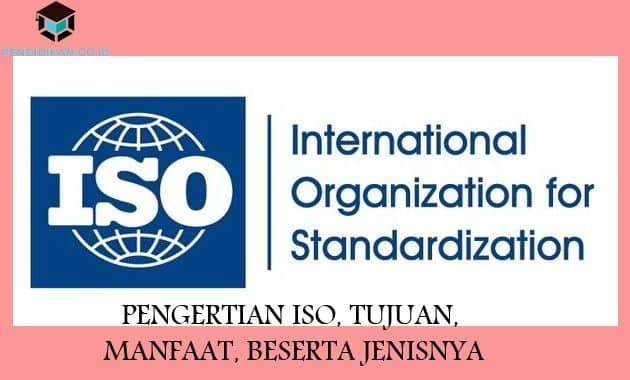Definition of ISO, its purpose, benefits, and its types
Education. Co. ID – On this occasion we will discuss about ISO which stands for The International Organization for Standardization, which is an International Organization for Standardization Standardization that sets international standards in the industrial and commercial fields of the world, the purpose of which is to increase trade between countries in this world. For more details below:

Definition of ISO (International Organization Standardization)
ISO is one of the international standard-setting bodies consisting of representatives from national standardization bodies in each country to measure the quality of an organization. That is, every company that wants to compete globally can be measured for its credibility with ISO standards.
This ISO organization is a party that plays a role in facilitating international trade and also making everything run smoothly. The ISO provides world-class specifications for everything from products, services and systems, to ensure quality, safety and efficiency.
In short, a company or brand that has been certified by ISO will have a better chance of winning the global market competition. The reason is, the company or brand already has or has product quality assurance (goods or services) from ISO so that it gets the value of trust from consumers.
Purpose and Benefits of ISO (International Standards Organization)
Basically the purpose and benefits of ISO is to determine international standards in the industrial and commercial fields. Based on the definition of ISO above, the benefits of ISO are as follows:
1. Increase Company Credibility
A company that establishes a quality management system in accordance with international standards will guarantee the credibility of the company. That is, all activities / activities carried out by the company already have the best standards which in the end will produce positive values in terms of customer satisfaction.
2. Increase Consumer Confidence
With regard to benefit number 1, customer/consumer satisfaction is very important because it will make them more trust in the company and will become customers loyal.
3. Quality Assurance According to International Standards
Every company that wants to have / have this ISO standardization certificate must go through a definite cycle called PDCA. The cycle is applied to all types of industries, where the identification, analysis, as well as execution of a problem solving to be able to guarantee quality according to standards international.
4. Save cost
With the ISO standard, a company will implement a special management system that can help to know the company's performance. When there are indications that the company's performance will decline or the product will fail, there are efforts to anticipate to improve it.
This process will indirectly prevent the occurrence of budget wastage related to poor performance and also the product.
5. Optimizing Employee Performance
Referring to the principles of quality management, all standards are set to be implemented by all employees. This can motivate employees to continue to maintain their quality, efficiency, and also their productivity according to the established ISO standards.
6. Improve Company Image
The advantage that can be felt directly by companies from ISO certification is to increase the image or brand of a company to be much better not only in the eyes of the world.
ISO Types
In general, there are eight (8) types of ISO standards issued by this International Organization and many have also been applied in companies in Indonesia. Below are some types of ISO including the following:
-
ISO 9001
It is the most widely used quality management system, which in its characteristics is a process approach that aims to improve the effectiveness of quality management.
-
ISO 14001
Is a standard related to environmental management systems. Some of the aspects that must be met in this standard are waste management, energy savings, water savings, and also fuel savings.
-
ISO 22000
Is a standard related to food safety management systems. The standard is intended for companies in the food and beverage sector, which are required to can carry out internal control, and each of these products must have a process plan as well as control.
-
ISP/IEC 27001
Is an information security management system standard or also Information Security Management System (ISMS). These standards are applied to companies in the field of IT applications and the like.
-
ISO TS 16949
Is a technical specification for a quality management system in the automotive industry. The concept of this standard is continual improvement, supply chain control, and preventive and corrective action.
-
ISO/IEC 17025
Is a standard associated with a testing agency or laboratory. This standard aims to ensure the accuracy of test results in the fields of health, production, trade, as well as consumer protection.
-
ISO 28000
Is a standard related to supply chain security systems for high-risk companies, such as banks, mining, hotels, and others.
-
ISO 5001
Is a standard applied to energy management systems so that companies have systems to improve performance, efficiency, and energy consumption.
Now that's an explanation of the definition of ISO, its objectives, benefits, and its types, hopefully what is described above can be useful for you. thank you
See AlsoDefinition of Transportation, Elements, Functions, Benefits, Types and Examples
See AlsoUnderstanding Rutherford Atom, Theory, Strengths and Disadvantages
See AlsoUnderstanding Logistics
